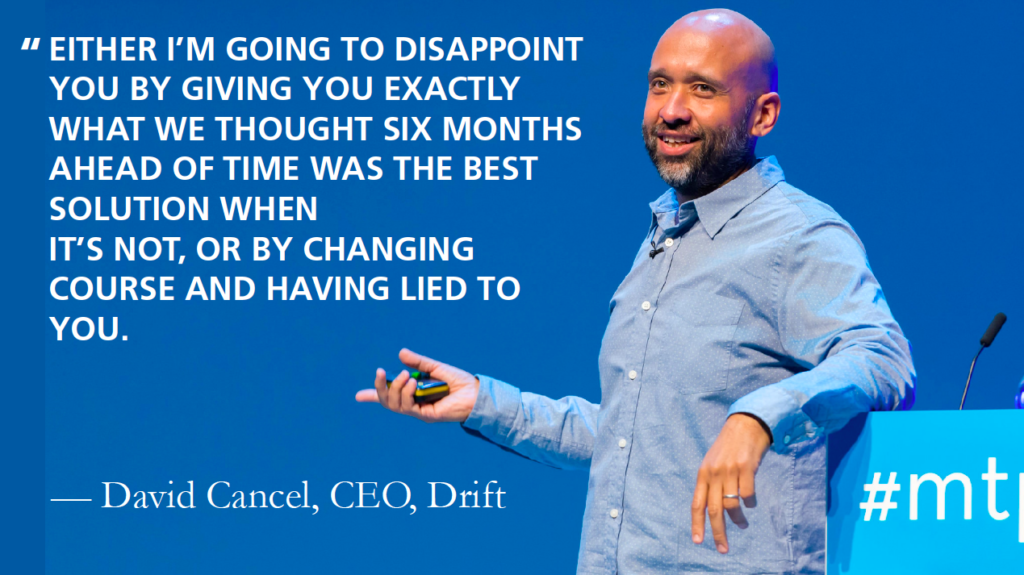Product managers mostly hate roadmaps, says Phil Terry, who put it even more bluntly in the title of his article product roadmapping sucks. Serial Boston entrepreneur and current Drift.com CEO David Cancel generally agrees:

Some have even gone so far as to write a “Dear John” letter to their roadmap/process! These letters and the countless conversations we have with product leaders in our workshops highlight the many problems with roadmaps that don’t work, including:
- have no connection to business strategy
- don’t include enough customer feedback
- lack objective criteria for prioritization
- are too often used as a sales tool
- lead to broken promises (see Cancel above)
- are out of date almost as soon as they are published
- are all about solutions rather than the needs and the problems of your customers
But roadmaps are here to stay, so you might as well figure out how to make them work for you and your product teams. Your senior leadership and your customers are unlikely to stop asking for them.
To that end, we listed some of the key steps you should include as part of creating a successful product roadmap for your organization. You should note that every company, product, and set of stakeholders is different. So mix and match based on your situation and what works for your organization.
#1 Gather inputs
The roadmap is often the final step in the strategic planning process, which means you’ll already have several assets to draw from to make it better. Among the required inputs of the roadmap planning process are:
- Clearly defined problem and solution. Why do you need this? You have to know what you’re doing and why that’s valuable before you start thinking about where you’re going.
- Understand your users needs. Why do you need this knowledge? You need to be able to empathize with your users so you can understand and anticipate their needs. More on this below in Step #3.
- User Journeys for the current experience. Why the current experience? You need to fully visualize or map how they are currently solving their problem in order to understand how it will be improved or replaced by your offering.
Make sure to develop and discuss these inputs with your stakeholders, or you’ll risk inserting your own biases and assumptions into the process.
#2 Establish a product vision
You don’t have a product vision? Oh, that could be an issue. Not to worry, here’s a short visioning exercise from Geoffrey Moore’s Crossing the Chasm.
When: at a time when____
What: [our product] is the only____
How: that____
Who: for_____
Where: in______
Why: who_____
So when it’s complete the vision exercise will look something like this (this is an example from a travel advisory company):
At a time when travel is frequent, but travelers plan less…
TripAdvisor has the only international restaurant recommendation engine…
That gives immediate recommendations based on location and reviews…
For the everyday traveler…
From countries all over the world….
Who need to save time and energy on finding local eateries.
#3 Uncover customer needs
This is the most important part of your roadmap process. When you are myopically focused on tasks, functions, and features, you are missing the opportunity to serve your customer’s true needs. So often, serving that need also becomes your competitive advantage. Jobs To Be Done is a good way to uncover these needs to ensure you are addressing them appropriately in your roadmap.
#4 Dive deeper into these needs and potential solutions
Most companies can tell you the exact age, race, marital status, salary, and lifestyle preferences of their target customers, but many can’t tell you why their customers buy from them. This largely demographic data completely ignores the root of the customer need. For that you have to dig deeper to uncover the true reasons, many of which are more about emotion than function. In their HBR article, Christensen, Hall, Dillon, & Duncan posit that “Jobs aren’t just about function — they have powerful social and emotional dimensions”.
#5 Master the art and science of prioritization
The biggest challenge to getting things done is knowing WHAT to get done — prioritization. Choosing one thing over another means saying ‘no’ to someone. That someone might be a customer, a salesperson or a board member. It doesn’t matter who you’re saying ‘no’ to, it’s still hard to do.
Product gurus like Rich Mironov, Ken Norton and Martin Eriksson have written about why product leaders are responsible for product success without having the requisite authority to drive those decisions through the organization.
Product Prioritization with Confidence
Prioritization is such a huge challenge among product leaders that we decided to write a guidebook about it.
To download this report, please tell us a little about yourself:
#6 Achieve buy-in and alignment
The best roadmap ever created will still likely fail to achieve the desired outcomes without achieving buy-in and alignment with the people who will fund it, execute it, and receive its outputs. The roadmap should help to create this alignment by getting the entire team working towards the same goals.
#7 Present and share
A roadmap shouldn’t be considered complete unless and until it has been socialized and discussed with the broader team so that they have clarity on what their roles are and what their efforts will create. This includes all stakeholders including what is often the core product team of product owner(s), design, engineers but also including the broader team of QA, customer success, sales, senior leadership, strategic vendors/partners, and other product teams. Importantly, it also should include your customers and the market. After all, they are the ones who will need and want to know what value will be coming their way. Remember, at its core, a roadmap is a strategic communication artifact that is focused on the big picture and conveys the path you’ll take to fulfill your product vision.
#8 Keep it fresh
A roadmap is not a static document. When conditions in the environment/market change, so too must your roadmap change in order to survive and remain relevant. It’s one of the biggest reasons roadmaps fail (and why so many product managers despise them) – when product teams publish a roadmap and consider it done.
One way to avoid this is to focus on themes rather than features and dates. Themes focus the team’s efforts on high-level customer needs, problems, or jobs to be done. And they are often best communicated in broad timeframes like Now, Next, and Later.
One thing is for sure – your roadmap will be out-of-date almost as soon as it’s published. So take care to constantly evaluate it against your market and your customers’ needs over time.
Ready to learn more?
Do you need to relaunch your product roadmapping process? If so, you are in luck! We’ve worked with the authors of Product Roadmaps Relaunched to create a Roadmap Relaunch Kit to help you get started down the path of more meaningful (and helpful) product roadmaps.
